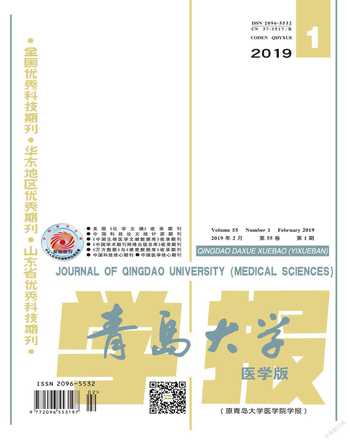经鼻给枸橼酸铁铵对小鼠嗅觉、嗅球铁含量及TH蛋白表达影响
王冬霞 谢俊霞 宋宁
[摘要] 目的 了解经鼻给枸橼酸铁铵对小鼠嗅觉、嗅球铁含量及酪氨酸羟化酶(TH)表达影响。
方法健康雄性C57BL/6小鼠40只,随机分成两组,各20只。实验组双侧交替经鼻给枸橼酸铁铵(200 mg/kg),隔天1次,持续3周;对照组则给予等量生理盐水。3周后,经嗅觉测试检测两组小鼠嗅觉,应用Perls铁染色联合二氨基联苯胺(DAB)强化的方法检测嗅球铁阳性细胞数,运用免疫印迹法检测嗅球TH表达。
结果 与对照组比较,实验组小鼠嗅觉明显减退,嗅球铁染色阳性细胞数明显增加,TH表达水平显著下降,差异有统计学意义(t=2.266~4.801,P<0.05)。
结论经鼻给枸橼酸铁铵能够引起小鼠嗅球铁沉积和多巴胺能神经元损伤。
[关键词] 枸橼酸铁铵;经鼻给药;酪氨酸单氧化酶;铁;小鼠
[中图分类号] R338
[文献标志码] A
[文章编号] 2096-5532(2019)01-0013-04
EFFECT OF INTRANASAL ADMINISTRATION OF FERRIC AMMONIUM CITRATE ON OLFACTORY FUNCTION AND IRON CONTENT AND PROTEIN EXPRESSION OF TYROSINE HYDROXYLASE IN THE OLFACTORY BULB IN MICE
WANG Dongxia, XIE Junxia, SONG Ning
(Department of Physiology and Pathephysiology, Medical College of Qingdao University, Qingdao 266071, China)
[ABSTRACT]ObjectiveTo investigate the effect of intranasal administration of ferric ammonium citrate on olfactory function and iron content and the protein expression of tyrosine hydroxylase (TH) in the olfactory bulb in mice.
MethodsA total of 40 healthy male C57BL/6 mice were randomly divided into control group and experimental group, with 20 mice in each group. The mice in the experimental group were given intranasal administration of ferric ammonium citrate (200 mg/kg) at both sides alternatively once every other day for 3 consecutive weeks, and those in the control group were given an equal volume of normal saline without ferric ammonium citrate. After three weeks, the olfactory test was performed to evaluate olfactory function, Perls iron staining combined with diaminobenzidine enhancement was used to measure the number of iron-positive cells in the olfactory bulb, and Western blotting was used to measure the expression of TH in the olfactory bulb.
ResultsCompared with the control group, the experimental group had a significant reduction in olfactory function, a significant increase in the number of iron-positive cells in the olfactory bulb, and a significant reduction in the expression of TH (t=2.266-4.801,P<0.05).
ConclusionIntranasal administration of ferric ammonium citrate can induce iron deposition and dopaminergic neuronal injury in the olfactory bulb in mice.
[KEY WORDS]ferric ammonium citrate; intranasal administration; tyrosine 3-monooxygenase; iron; mice
鐵是正常生命活动中必需微量元素,参与所有生物体多种重要的生理、生化过程,包括氧运输、线粒体呼吸、细胞生长分化以及金属酶活性位点的形成,在脑内铁对于维持神经组织的高代谢、能量需求、髓鞘合成、神经递质合成以及新陈代谢等发挥着至关重要的作用[1-3]。然而,过多的铁可能通过哈伯-韦斯反应和芬顿反应引起氧与过氧化氢发生有害反应,并形成高反应性和极具破坏性的羟自由基(OH-),从而造成组织细胞氧化应激损伤[4]。帕金森病(PD)是第二大常见中枢神经系统退行性疾病,多见于中老年人,以脑内黑质致密部多巴胺能神经元缺失和路易小体形成为主要病理改变[5]。在正常情况下,脑铁水平升高是衰老的正常特征之一[6-7]。而在尸检和活体脑检测均发现,PD病人黑质区多巴胺能神经元损伤的区域同时还存在着铁的异常沉积[2,8-9],多巴胺代谢与多种铁依赖/非依赖通路有关,且有神经毒性代谢产物生成[10]。因而,铁和多巴胺被认为是一对毒性组合,高铁介导的多巴胺神经毒性可能是多巴胺能神经元损伤的重要机制之一[9,11]。嗅觉系统内广泛分布有多巴胺能神经元和多巴胺受体,其中嗅球内10%~16%的球周颗粒层细胞为多巴胺能细胞。
1 材料与方法
1.1 实验动物及试剂
取8周龄SPF级C57BL/6雄性小鼠40只,购自北京维通利华实验动物有限公司,单笼饲养于洁净动物房内,置适量食物和水,供小鼠自由饮用。室温(20±2)℃,湿度(50±2)%,昼夜循环(12/12 h)光照条件,于本实验室饲养适应1周。FAC购于美国Sigma公司,其余试剂均从当地试剂公司购买。用生理盐水溶解FAC,浓度为250 g/ L。
1.2 动物分组及处理
将小鼠随机分为两组,各20只。实验组给予浓度为250 g/L的FAC溶液,间隔1 d经双侧鼻孔交替给药(200 mg/kg);对照组给予同等体积的生理盐水。用药3周后停药3周,对两组小鼠进行相应指标检测。
1.3 检测指标及方法
1.3.1嗅觉检测 将小鼠置于透明的矩形盒内,盒子中间插入带有拱形通道的透明隔板。在隔板的一侧铺放全新的垫料(相对陌生的味道环境),另一侧铺放小鼠生活过3 d的旧垫料(相对熟悉的味道环境)。小鼠可以通过拱形通道在新旧垫料两侧自由穿梭。应用Ethvision XT 7系统追踪小鼠5 min的活动情况,以小鼠在熟悉味道环境中逗留总时长反映小鼠嗅觉的灵敏度。
1.3.2嗅球铁染色阳性细胞数目检测 将切好的脑片转移至40 g/L多聚甲醛溶液内固定5 min,转移至去离子水中漂洗30 s,以20 g/L亚铁氰化钾与20 g/L盐酸溶液等体积的混合液(现配现用)孵育30 min;转移至 0.01 mol/L 的PBS中漂洗3次,每次5 min;以体积分数0.01的H2O2-甲醇溶液封闭20 min,灭活假阳性过氧化物酶和内源性过氧化氢酶;用0.01 mol/L的PBS冲洗3次,每次5 min;二氨基联苯胺(DAB)溶液避光显色10~30 min,于显微镜下观察显色情况;双蒸水终止显色。将显色后的脑片展平,铺于干净的载玻片上,充分干燥后用中性树胶封片;明场显微镜下观察、拍片,进行细胞计数。在10倍物镜下取嗅球铁阳性细胞最明显处5个视野,分別对其内的铁阳性细胞进行计数,取其平均值。
1.3.3免疫印迹法检测嗅球部位酪氨酸羟化酶(TH)表达 取新鲜的嗅球组织,加入RIPA裂解缓冲液,置于冰上裂解30 min,然后收集到EP管中,4 ℃、12 000 r/min离心20 min,吸取上清液至新EP管中,应用BCA方法检测嗅球内的蛋白浓度。之后将蛋白样品经SDS-PAGE电泳,并湿转至PVDF膜上,用浓度为50 g/L的脱脂奶粉室温摇床封闭2 h,用TH(1∶3 000)、β-actin(1∶10 000)一抗于4 ℃摇床过夜,用1∶10 000的山羊抗兔HRP-IgG二抗室温孵育1 h,ECL发光液显影,用 Image J 图像采集和分析软件进行条带灰度分析。
1.4 统计学处理
应用Prism 5软件进行统计分析,结果以[AKx-D]±s表示,两组间比较采用t检验。 P<0.05表示差异有统计学意义。
2 结 果
2.1 两组小鼠嗅觉功能比较
对照组小鼠在旧、新垫料活动时间比值为2.004±0.203(n=17),实验组小鼠为1.454±0.118(n=15),两组相比较差异有统计学意义(t=2.266,P<0.05)。
2.2 两组小鼠嗅球区铁含量比较
对照组小鼠铁染色阳性细胞计数为72.31±7.67(n=3),实验组为130.90±9.48(n=3),两组比较差异有统计学意义(t=4.801,P<0.05)。
2.3 两组小鼠嗅球区TH蛋白表达比较
对照组小鼠嗅球TH蛋白与β-actin蛋白比值为0.829±0.262(n=6),实验组为0.192±0.034(n=7),两组比较差异有统计学意义(t=2.618,P<0.05)。
3 讨 论
基于高铁动物模型的大量研究显示,PD动物具有某些行为学改变及病理学特征[9,12-13],但大多数高铁动物模型的给药方式是外周给铁(例如高铁饲料)等,由于血-脑脊液屏障(BBB)的存在,铁主要在外周沉积,无法有效模拟动物脑内高铁环境。而经鼻给药则可以有效避开BBB进入中枢神经系统[14-15]。目前研究认为,经鼻给药进入中枢神经系统可能存在两条途径:①药物先进入嗅细胞,然后沿嗅神经通路经由神经元轴突间转运到达嗅球,最后
广泛分布于大脑实质;②通过支持细胞间紧密连接方式或是以某种细胞外途径通过支持细胞与嗅细胞之间开放的缝隙进入中枢。已有研究显示后者更快速,只需几分钟[16-20]。小分子和大分子生物制剂,如蛋白质、基因载体和干细胞,均有报道可经鼻途径进入脑内。已有研究表明,经鼻给予胰岛素样生长因子-1,能够有效减少大脑中动脉闭塞模型大鼠梗死体积和神经功能缺损。经鼻给予神经生长因子能极大逆转阿尔茨海默病模型小鼠的神经变性和记忆丧失[21-22]。在健康成年人和遗忘性轻度认知功能障碍或阿尔茨海默病早期,经鼻给予胰岛素后记忆能力能够有效改善[23-25]。本实验使用Perls铁染色联合DAB强化的方法,检测经鼻给FAC小鼠嗅球区铁沉积情况,结果显示,FAC经鼻给药组小鼠嗅球区铁染色阳性细胞计数较对照组明显增多,差异有统计学意义。由于神经胶质细胞是脑内主要的铁储存细胞,且本实验铁染色阳性细胞呈现胶质细胞而并非神经元的形态特征,提示经鼻给予FAC能导致小鼠嗅球区铁在神经胶质细胞中沉积。
有研究显示,嗅觉损伤与多巴胺能神经元损伤有关[26]。本实验利用小鼠有在熟悉环境内逗留的习性对小鼠嗅觉的灵敏度进行检测,结果显示,小鼠经鼻给FAC后在熟悉环境内逗留时间与对照组相比明显缩短,说明经鼻给予FAC后,小鼠嗅觉功能减退。TH是脑内多巴胺合成的限速酶,其结构域由150个氨基酸构成,通过四氢生物蝶呤和分子氧将酪氨酸转化为左旋多巴,以调节酶活性,是脑内多巴胺能神经元的细胞标志物。本文结果表明,实验组TH表达水平较对照组显著下降,差异有统计学意义。已有研究表明,嗅球内多巴胺能神经元在气味的感觉、辨别和学习过程中发挥着关键作用。我们推测经鼻给FAC引起嗅球部位铁聚集,沉积的铁可能导致多巴胺能神经元损伤,表现为TH蛋白水平降低。
综上所述,经鼻给FAC可以引起嗅球部位铁聚集,损伤多巴胺神经元。在此基础上,我们将继续研究经鼻给FAC后其他脑区铁含量的变化。本文结果为进一步研究经鼻途径给予铁对中枢神经系统铁含量和多巴胺神经元的影响提供实验和理论基础。
[参考文献]
[1]BELAIDI A A, BUSH A I. Iron neurochemistry in Alzheimers disease and Parkinsons disease: targets for therapeutics[J]. Journal of Neurochemistry, 2016,139(1):179-197.
[2]JIANG H, WANG J, ROGERS J, et al. Brain Iron metabolism dysfunction in Parkinsons disease[J]. Molecular Neurobiology, 2017,54(4):3078-3101.
[3]CRICHTON R R, DEXTER D T, WARD R J. Brain Iron metabolism and its perturbation in neurological diseases[J]. Journal of Neural Transmission (Vienna, Austria:1996), 2011,118(3):301-314.
[4]LOCHHEAD J J, THORNE R G. Intranasal delivery of biologics to the central nervous system[J]. Advanced Drug Deli-very Reviews, 2012,64(7):614-628.
[5]LEAK R K. Conditioning against the pathology of Parkinsons disease[J]. Cond Med, 2018,1(3):143-162.
[6]WARD R, ZUCCA F A, DUYN J H, et al. The role of Iron in brain ageing and neurodegenerative disorders[J]. Lancet Neurology, 2014,13(10):1045-1060.
[7]PIRPAMER L, HOFER E, GESIERICH B, et al. Determinants of iron accumulation in the normal aging brain[J]. Neurobiol Aging, 2016,43:149-155.
[8]OLIVEIRA BARBOSA J H, SANTOS A C, TUMAS V, et al. Quantifying brain Iron deposition in patients with Parkinsons disease using quantitative susceptibility mapping, R2 and R2[J]. Magnetic Resonance Imaging, 2015,33(5):559-565.
[9]ZUCCA F A, SEGURA-AGUILAR J, FERRARI E A, et al. Interactions of Iron, dopamine and neuromelanin pathways in brain aging and Parkinsons disease[J]. Progress in Neurobio-logy, 2017,155(SI):96-119.
[10]EXNER N, LUTZ A K, HAASS C A. Mitochondrial dysfunction in Parkinsons disease: molecular mechanisms and pathophysiological consequences[J]. EMBO Journal, 2012,31(14):3038-3062.
[11]呂占云,姜宏,徐华敏,等. 高铁饮食致C57BL/6小鼠黑质DA多巴胺能神经元选择性损伤的研究[J]. 青岛大学医学院学报, 2010,46(4):298-300.
[12]MOOS T, MORGAN E H. The metabolism of neuronal iron and its pathogenic role in neurological disease: review[J]. Ann N Y Acad Sci, 2004,1012:14-26.
[13]CAROCCI A, CATALANO A, SINICROPI M S. Oxidative stress and neurodegeneration: the involvement of Iron[J]. BioMetals, 2018,31(5):715-735.
[14]KAMEI N. Nose-to-Brain delivery of peptide drugs enhanced by coadministration of cell-penetrating peptides: therapeutic potential for dementia[J]. Yakugaku Zasshi : Journal of the Pharmaceutical Society of Japan, 2017,137(10):1247-1253.
[15]MIYAKE M M, BLEIER B S. The blood-brain barrier and nasal drug delivery to the central nervous system[J]. American Journal of Rhinology & Allergy, 2015,29(2):124-127.
[16]THORNE R G, PRONK G J, PADMANABHAN V, et al. Delivery of insulin-like growth factor-Ⅰ to the rat brain and spinal cord along olfactory and trigeminal pathways following intranasal administration[J]. Neuroscience, 2004,127(2):481-496.
[17]MITTAL D, ALI A, MD S, et al. Insights into direct nose to brain delivery:current status and future perspective[J]. Drug Delivery, 2014,21(2):75-86.
[18]THORNE R G, HANSON L R, ROSS T M, et al. Delivery of interferon-beta to the monkey nervous system following intranasal administration[J]. Neuroscience, 2008,152(3):785-797.
[19]HANSON L R, FREY I W. Intranasal delivery bypasses the blood-brain barrier to target therapeutic agents to the central nervous system and treat neurodegenerative disease[J]. BMC Neuroscience, 2008,9(3):S5.
[20]BOURGANIS V, KAMMONA O, ALEXOPOULOS A A. Recent advances in carrier mediated nose-to-brain delivery of pharmaceutics[J]. European Journal of Pharmaceutics and Biopharmaceutics, 2018,128:337-362.
[21]CAPSONI S, UGOLINI G, COMPARINI A, et al. Alzheimer-like neurodegeneration in aged antinerve growth factor transgenic mice[J]. Proceedings of the National Academy of Sciences of the United States of America, 2000,97(12):6826-6831.
[22]DE ROSA R, GARCIA A A, BRASCHI C, et al. Intranasal administration of nerve growth factor (NGF) rescues recognition memory deficits in AD11 anti-NGF transgenic mice[J]. Proceedings of the National Academy of Sciences of the United States of America, 2005,102(10):3811-3816.
[23]MAO Yanfang, GUO Zhangyu, ZHENG Tingting, et al. Intranasal insulin alleviates cognitive deficits and amyloid patho-logy in young adult APPswe/PS1dE9 mice[J]. Aging Cell, 2016,15(5):893-902.
[24]CLAXTON A, BAKER L D, HANSON A, et al. Long-acting intranasal insulin detemir improves cognition for adults with mild cognitive impairment or early-stage Alzheimers disease dementia[J]. Journal of Alzheimers Disease: JAD, 2015,45(4):1269-1270
[25]SHEMESH E, RUDICH A, HARMAN-BOEHM I A. Effect of intranasal insulin on cognitive function: a systematic review[J]. Journal of Clinical Endocrinology & Metabolism, 2012,97(2):366-376.
[26]DENG X L, LADENHEIM B, JAYANTHI S, et al. Methamphetamine administration causes death of dopaminergic neurons in the mouse olfactory bulb[J]. Biological Psychiatry, 2007,61(11):1235-1243.

